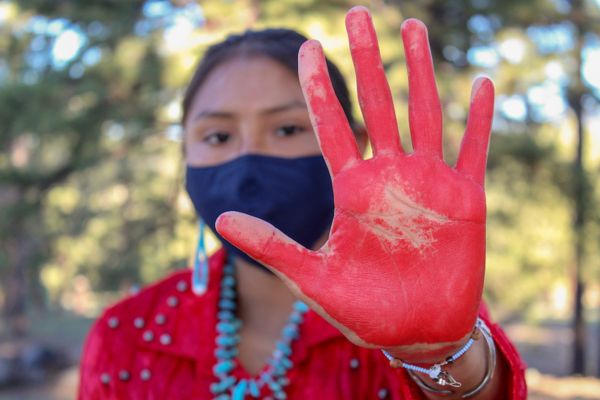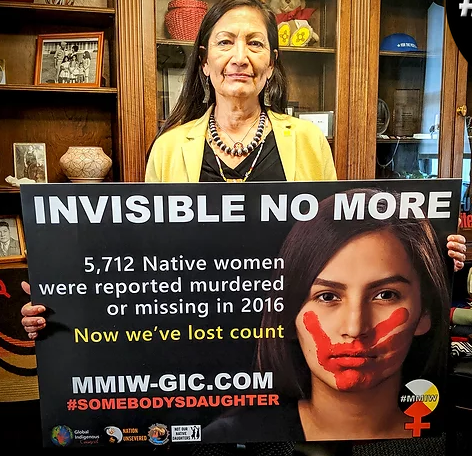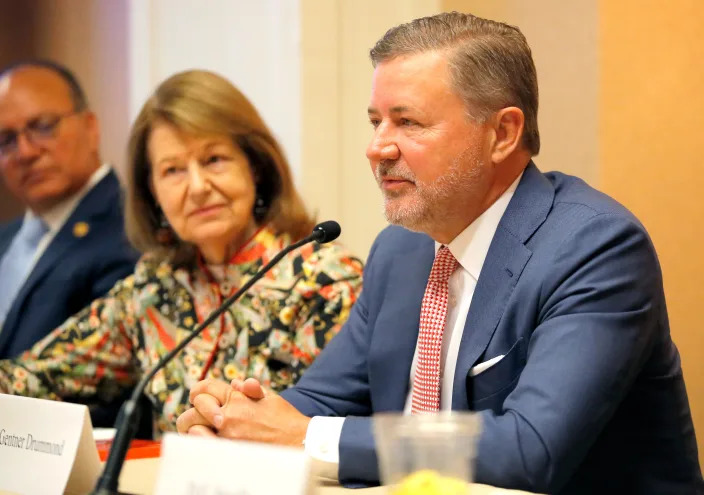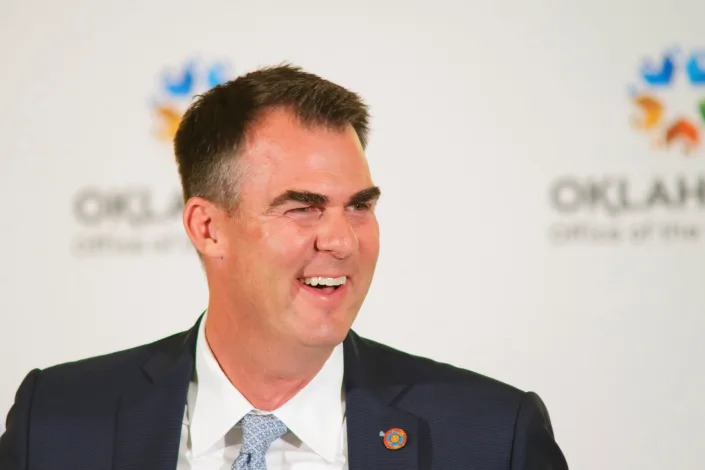America’s Proto-Fascist Red Scare of 1917-21

Is This Tomorrow?, a 1947 anti-Communist comic book via Wikimedia Commons
Adam Hochschild, American Midnight: The Great War, a Violent Peace, and Democracy’s Forgotten Crisis (New York: Mariner, 2022).
As American as Cherry Pie
Those who think that fascism is impossible in the United States thanks to the nation’s supposed splendid and “exceptional” record of freedom, democracy, equality, decency, and respect for the rule of law[1] might want to read up on the vast dark undersides of American history. Slavery happened here, for two and a half centuries. Jim Crow segregation, disenfranchisement, and terrorism happened here for nearly a century. Native American removal and genocide happened here over three centuries. Mass Black ghettoization took place in the last century and remains intact today. Racist mass arrest, imprisonment, and criminal branding has been happening for more than half a century.
From its genocidal and slave-based origins through its recurrent bloody repression and oppression of workers and radicals, its savage levelling and privatization of North American forests and prairies. its building of a giant authoritarian corporate system, its manufacture of vast urban Black ghettoes, its creation of a globally unmatched racist mass incarceration system, its ongoing police state brutalization of its minority populations, its construction of a giant mass murderous and racist global empire, its direct and indirect murder of tens of millions of world citizens, and its creation of a massive surveillance state at home and abroad, the real, by means glorious record of “the American experience,” properly examined, suggests that in many ways fascism is, like violence, to paraphrase the 1960s Black radical H. Rap Brown, “as American as cherry pie.”[2]
As the heralded Black novelist Toni Morrison observed in a 1995 Howard university speech titled “Racism and Fascism,” “America has often preferred fascist solutions to political problems.”[3]
On the Brink, 1917-21
Fascism can’t happen here? It kind of did between 1917 and 1921, when the First World War and the Russian Bolshevik (socialist) Revolution provided “patriotic” pretext for American federal, state, and local government and right-wing anti-labor, anti-radical, and racist vigilantes to arrest, terrorize, beat, incarcerate, torture, and murder US pacifists, leftists, feminists, immigrants, Blacks, Jews, civil libertarians, and trade unionists from coast to coast. As Adam Hochshild shows in his remarkable latest book American Midnight: The Great War, a Violent Peace, and Democracy’s Forgotten Crisis (New York: Mariner, 2022), the nation teetered on the brink of a proto-fascist dictatorship during and after the war. Armed white mobs torched Black churches and business and levelled whole Black communities, killing hundreds of African Americans. The federal 1917 Espionage Act and 1918 Sedition Act and state-level versions of these draconian bills were used by prosecutors and judges to throw thousands into prison for voicing real or perceived opposition to the war. The US Army joined state militias, local gendarmes, vigilantes, and private detectives in bloodily repressing labor strikes driven by wartime inflation and labor demand. Local police red squads and a new federal police state including a new Military Intelligence bureaucracy and the Bureau of Investigation (precursor to the notorious anti-radical Federal Bureau of Investigations [FBI]) and a censorial US Post Office combined with white nationalist outfits like the American Protective League and the American Legion to decimate the once radical US Left, including the Industrial Workers of the World and the Socialist Party. The US Departments of Justice Department and Immigration Bureau deported hundreds accused of leftist and antiwar sentiments.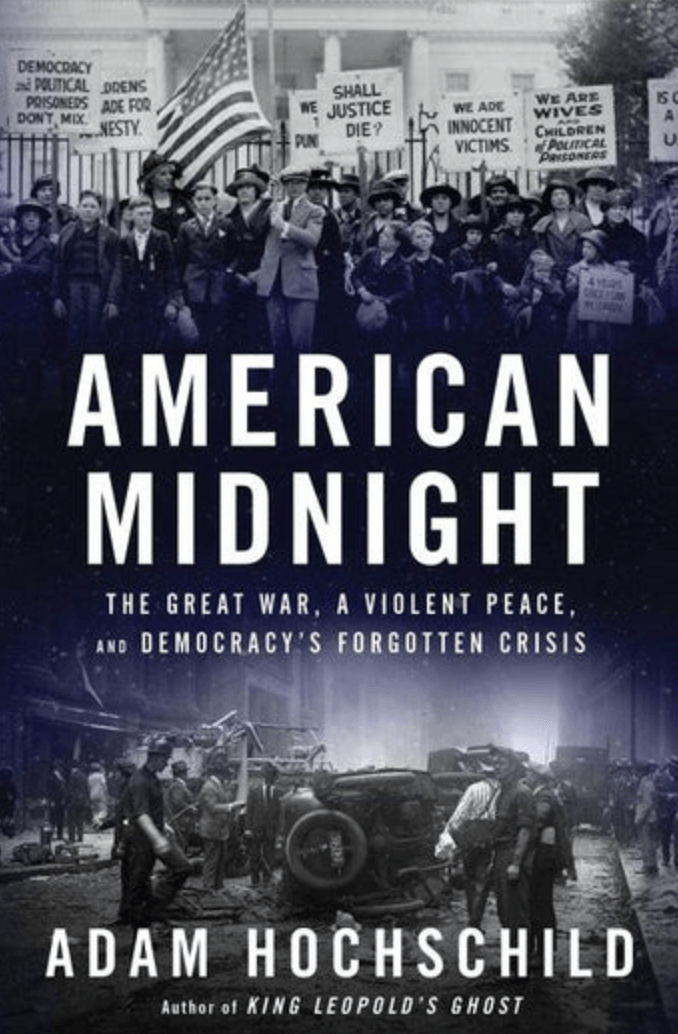
Some of the repression Hochschild recounts reads like dark comedy: three German-Americans in Cincinnati convicted under the Espionage and Sedition Acts after the local Citizens Patriotic League hired private detectives who put a wire in a shoemakers’ shop to record them privately saying that the war was making “somebody rich;” a Boston Symphony conductor arrested on the pretext that his musical score contained secret messages to the German military; the arrest of playwright Eugene O’Neil because someone worried that the sun reflecting off his typewriter on a Cap Cod beach was actually O’Neil sending coded messages to German submarines.
But there’s little funny about the bigger and ugly story told in American Midnight. Pacifists and socialists swept up into local jails and military concentration camps during and after the war were beaten, stabbed, shackled to prison bars on their tip toes, jerked around with ropes around their necks, threatened with summary execution, and immersed in human waste. Some were subjected to “the water cure,” the precursor of contemporary waterboarding– an insidious form of torture developed by US interrogators in the imperial subjugation of the Philippines earlier in the century. Members of the anarcho-syndicalist Industrial Workers of the World were beaten, tarred and feathered, and driven out into the wilderness to be dumped with warnings to never return to the industrial towns from which they were kidnapped. The veteran IWW organizer Frank Little was dragged from behind the back of a car and hung to death on a railway bridge outside Butte, Montana.
Talk about “fascist solutions to political problems”!
“Blacks Lived in Fear”…“Many Dead Bodies Were Thrown in the Mississippi River”
As so often in United States history, the worst violence was inflicted on Black people. Here is one the many horrible stories told in American Midnight:
“The military made sure that, even in uniform, Blacks lived in fear. At Camp Dodge, in Iowa, for example, all men stationed there were ordered to witness the hanging of three Black soldiers who had allegedly raped a young white woman…The 3,000 troops of the all-Black 92nd Division in training at the camp were deliberately placed in the front ranks before the specially constructed gallows.. ‘All were unarmed,’ reported one eyewitness, ‘while the white soldiers and officers were armed with rifles and revolvers.’ Horror-stricken, Black men who had hoped that serving in the military might led to a better life found themselves forced to watch what looked all too much like a lynching…It was a …shattering experience… ‘The cries of the condemned men echoed and echoed {a local newspaper reported]. Soon the shrieks of Negro soldiers, unwilling and terrified spectators, driven into a hysterical state, added to the sickening scene.’” (American Midnight, p. 115)
Lynchings? Hochschild describes many examples of that terrible practice deployed against Black Americans during and after the war (see pages 107-08, 114, 115, 138, 250-52). He also records the lynching of a German American socialist coal miner (Robert Prager) in Illinois (pp. 157-58) and the attempted lynching of “Omaha’s unusually enlightened mayor, Edward Smith,” for trying to intervene against a white, Omaha, Nebrasksa, mob that burned down a courthouse containing a Black man accused of raping a white woman in the summer of 1919.
Omaha was the scene for one the many “white riots” – racist pogroms – that took place in more than two dozen US during the “red summer” of 1919. “The worst violence of all,” Hochschild notes:
“was in Phillips County, Arkansas. The killers included American Legion members who joined a sheriff’s posse, other vigilantes from outside the county, and 550 federal troops. There were at least 103 known Black deaths, but some estimates put the total number at double that or higher. One reason nobody could completely pin down the toll, in an echo of what happened in East St. Louis two years earlier, is that many dead bodies were thrown in the Mississippi River…The Justice Department made no move to investigate the leaders of the white mobs that instigated almost all the killings, instead looking for signs of IWW or Bolshevik influence among Black protesters” (p. 255).
American Midnight’s epilogue mentions a soul-chilling anti-Black pogrom in which white vigilantes and local authorities burned down Tulsa, Oklahoma’s unusually large and prosperous Black business district. The fiery carnage left “more than 1,400 business and homes covering 35 blocks…in charred, smoking ruins” in late May and early June of 1921. The death toll reached 300, with nearly all the victims Black. “The National Guard arrested 4000 Black people, keeping many as long as eight days. No whites were taken into custody.” The cause was a spurious claim that a Black man had threatened a white woman. Reflecting the fascist spirit of the Red Scare times, the Los Angeles Times actually reported that “Bolshevik propaganda was the principal cause of the riot.” (pp. 355-56).
Personalities
Part of what makes Hochschild a popular author is his skill penchant for putting key individual faces on his narratives. Accordingly, American Midnight is loaded with biographical sketches of numerous key personalities in wartime and Red Scare America: the quasi-messianic Socialist Party presidential candidate Eugene Debs, who campaigns while incarcerated for voicing antiwar in 1920; the brilliant anarchist and feminist Emma Goldman, deported by the fiercely anti-radical US Attorney General A Mitchell Palmer; the young J. Edgar Hoover, future longtime anti-radical head of the FBI, who earns his fascist chops as a workaholic anti-radical Justice Department official during and after the war; the reactionary Quaker Palmer, who turn his anti-radical and deportation campaign into the basis for a failed Democratic Party presidential candidacy; the great feminist socialist Kate Richard O’Hare, incarcerated alongside Goldman; the proto-fascist warmonger and US Army general Leonard Wood, a close friend of his fellow arch-militarist and racist authoritarian Theodore Roosevelt, and a former US commander in the Philippines, who brutally suppressed coal and steel strikes, runs an internment camp that tortures pacifists and other war opponents, and seeks the Republican presidential nomination in 1920; the masterful agent provocateur Leo Wendell, who infiltrated the IWW under the name “Louis Walsh;” US Army Major Ralph Van Deman, who uses his experience of systematically identifying and cataloguing Filippino “insurgents” to create US Military Intelligence, a high-powered surveillance agency that tracked down radicals and war opponents; the racist Postal Commissioner Sindey Burleson, who banned leftist, anti-war, and civil rights literature from the mails; Louis Post, the progressive Assistant Secretary of Labor, who Hochschild lauds for cleverly and effectively opposing the anti-red and anti-immigrant scare, helping bring it to an end in 1921.
Hochschild naturally spills a lot of ink on the wartime president Woodrow Wilson, who was elected with significant progressive support but turned a blind eye to the savage repression and racist bloodshed that took place in the US and after he brought the nation into the European war. Wilson is depicted spending months in Europe soaking up British and French adoration while obsessively trying to advance his League of Nations while his own country slipped into a proto-fascist “midnight.” Wilson endures his final two years in office crippled by a stroke, kept out of the public eye and bitterly disappointed as the US Senate refuses to ratify American enlistment in doomed scheme make World War I “the war to end all wars.”
One Century Hauntingly Apart
The margins of my copy of American Midnight are full of exclamation points and comments like “holy shit,” “JFC,” “wow,” “ugh,” and the like. I thought I already knew most of what I needed to know about the proto-fascist madness let loose across the United States after Wilson brought the nation into the Great War, but Hochschild’s book suggests had only scratched the surface of this horrific episode.
American Midnight’s epilogue rightly notes that the presidency and politics of the Ku Kux Klansman’s son Donald J. Trump mirrored and channeled “the forces that blighted the America of a previous century:….rage against immigrants and refugees, racism, Red-baiting, fear of subversive ideas in school, and much more,” all buttressed “by the appeal of simple solutions: deport aliens, forbid critical journalism, lock people up, blame everything on those of a different color or religion” (pp. 356-57). In an especially incisive reflection, he notes that violent and angry veterans of earlier US wars against North American Indigenous people and the people of the Philippines played key roles in right wing repression during and after WWI “just as …veterans of later Asian counterguerrilla wars in Vietnam, Iraq, and Afghanistan have helped fill the ranks of new camouflage-clad armed militia groups” (p.357).
“Far From Perfect”
America at Midnight is a tour de force. It’s an at once engaging, brilliant, and chilling book – essential reading for anyone who wants a truthful account of United States history in the last century. Still, the volume should not be exempted from criticism by those more radically inclined like the present writer. Hochschild should not have held back from describing the repression and violence he recounts as fascist, a term that applies with accuracy to the Trumpism that he rightly links to the “American midnight” of 1917-21. Given his penchant for biography and the importance he rightly gives to anti-Black racism in this volume, Hochschild should have noted that President Wilson was a white supremacist who deepened the racial oppression that has defined so much of American history by: failing to confront Jim Crow disenfranchisement and terror; screening the despicable anti-Black movie Birth of a Nation at the White House in 1915; dismissing Black activists; and actively segregating the federal government. He might also have noted how centrally Wilson’s postwar vision for inter-imperialist peace was framed as a response to the Russian Revolution’s call for international proletarian and peoples’ socialist revolution,
Hochschild fails to give US left radicals their due. Louis Post certainly deserves the high praise Hochschild gives him for fighting back against the nativist Red Scare from within the federal bureaucracy, but far more valiant and exemplary were the radicals who went to jail in opposition to a mass-murderous capitalist-imperialist war they knew to be rooted in the competition for world markets, raw materials, colonies, investment outlets, and power between the world’s leading capitalist states. Debs, Goldman, O’Hare, and others who defied the state by militantly opposing the capitalist-imperialist war deserve top heroic billing. They endured incarceration and, in Goldman’s case, exile, for their properly radical politics.
Finally, Hochschild’s following comment near the end of his book is far too mild: “America’s version of democracy is far from perfect…” Far from perfect? Seriously? Please: America’s version of democracy has always been fraudulent cover for a de facto capitalist class dictatorship. The famed American novelist Henry Miller said something much closer to the truth at the height of World War II: “Our democracy has been the worst democracy that has ever been tried out. It has never had anything to do with freedom, has never been anything more than a name…” (Henry Miller, “Murder the Murderer,” June 25, 1944.)
“Our [non-]democracy” needs to be radically replaced by something at least partly along the lines of what Debs and other early 20th Century US radicals advocated – revolutionary socialism. Capitalism and its evil twin imperialism have brought the world to the precipice of environmental and epidemiological extermination and terminal thermonuclear war while hatching new forms of fascism that now pose grave threats to humanity. Hochschild may be correct to note that “most Americans have seldom dreamed of a [socialist] revolution,” but he’s wrong not to add that this is a problem requiring rapid correction. Americans had better start dreaming and organizing for such a revolution soon, for US-led capitalism-imperialism is bringing the human experiment to a conclusion at an ever-accelerating pace.
An earlier version of this review appeared on The Paul Street Report.
Endnotes
+1. This soothing, “American exceptionalist” idea lay at the heart of the dramatic political advertisement in which the corporate Democrat and twice-failed presidential Joe Biden announced his bid to run against Trump in the spring of 2019:
‘Charlottesville, Va., is home to the author of one of the great documents in human history. We know it by heart: “We hold these truths to be self-evident, that all men are created equal, endowed by their Creator with certain unalienable Rights.” We’ve heard it so often, it’s almost a cliché. But it’s who we are.
Charlottesville is also home to a defining moment for this nation in the last few years. It was there on August of 2017 we saw Klansmen and white supremacists and neo-Nazis come out in the open, their crazed faces illuminated by torches, veins bulging, and bearing the fangs of racism. Chanting the same anti-Semitic bile heard across Europe in the ‘30s. And they were met by a courageous group of Americans, and a violent clash ensued, and a brave young woman lost her life.
And that’s when we heard the words from the president of the United States that stunned the world and shocked the conscience of this nation. He said there were “some very fine people on both sides.” Very fine people on both sides?
With those words, the president of the United States assigned a moral equivalence between those spreading hate and those with the courage to stand against it. And in that moment, I knew the threat to this nation was unlike any I had ever seen in my lifetime.
I wrote at the time that we’re in the battle for the soul of this nation. Well, that’s even more true today. We are in the battle for the soul of this nation. I believe history will look back on four years of this president and all he embraces as an aberrant moment in time. But if we give Donald Trump eight years in the White House, he will forever and fundamentally alter the character of this nation — who we are…Folks, America’s an idea, an idea that’s stronger than any army, bigger than any ocean, more powerful than any dictator or tyrant. It gives hope to the most desperate people on earth, it guarantees that everyone is treated with dignity and gives hate no safe harbor. It instills in every person in this country the belief that no matter where you start in life, there’s nothing you can’t achieve if you work at it.
That’s what we believe. And above all else, that’s what’s at stake in this election.
We can’t forget what happened in Charlottesville. Even more important, we have to remember who we are. This is America.’
+2. Edward Baptist, The Half Has Never Been Told: Slavery and the Rise of American Capitalism (New York: Basic Books, 2016); Douglas Blackman, Slavery by Another Name: The Re-Enslavement of Black Americans From the Civil War to World War II (New York: Anchor Books, 2008); Ward Churchill, A Little Matter of Genocide: Holocaust and Denial in the Americas, 1492 to the Present (San Francisco: City Lights, 2001); Paul Street, Racial Oppression in the Global Metropolis (New York: Rowman & Littlefield, 2007); Paul Street, The Vicious Circle: Race, Prison, and Jobs (Chicago: Chicago Urban League, October 2002), https://www.prisonpolicy.org/scans/theviciouscircle.pdf ; Michelle Alexander, The New Jim Crow: Mass Incarceration in the Age of Color Blindness (New York: New Press, 2012); Martin J. Sklar, The Corporate Reconstruction of American Capitalism, 1890-1916 (Cambridge, MA: Cambridge University Press, 1988); Alfred Chandler, The Visible Hand: The Managerial Revolution in American Business (Cambridge, MA: Cambridge University Press, 1976); Wolin, Democracy Incorporated; Joel Bakan, The Corporation: The Pathological Pursuit of Profit and Power (New York: Free Press, 2005); Robert W. McChesney, Corporate Media and the Threat to Democracy (New York: Seven Stories Press, 1997); David Gordon, Richard Edwards, and Michael Reich, Segmented Work, Divided Workers: The Historical Transformation of Labor in the United States (Cambridge, MA: Cambridge University Press, 1982); Paul Street, They Rule: The 1% v. Democracy (New York: Routledge, 2014); Sheldon Wolin, Democracy Incorporated (Princeton University Press, 2008); Carol Boggs, Fascism Old and New: America at the Crossroads (New York: Routledge, 2018); Noam Chomsky, Deterring Democracy (New York: Hill & Wang, 1991); Noam Chomsky, World Orders Old and New (New York: Columbia University Press, 1996); Paul Street. “The World Will Not Mourn the Decline of U.S. Hegemony,” Common Dreams, February 22, 2018, https://www.commondreams.org/views/2018/02/22/world-will-not-mourn-decline-us-hegemony; Alfred McCoy, In the Shadows of the American Century: The Rise and Decline of U.S. Power (Chicago: Haymarket Books, 2017). Adolph Hitler (who named his early WWII train “Amerika”) and his fellow top Nazis seemed to agree with H Rap Brown’s judgement. Their racist, eugenicist, and Social Darwinian project was inspired to no small degree by the history of American genocide, slavery, continental conquest, and Jim Crow segregation, whose grisly record of racist lynching was alive and well when Hitler seized power in Germany. The United States’ racial separatism and terror policies and practices provided role models for Hitler and other European fascists, who also admired American mass production methods and the potent means of thought- and feeling-control developed by American advertisers and Hollywood. European fascism was Americanism to no small degree. Hitler’s Nuremberg Race Laws were based on the Jim Crow model to no small extent. See James Q. Whitman, Hitler’s American Model: The United States and the Making of Nazi Race Law (Princeton, NJ: Princeton University Press, 2017); Ira Katznelson, “What America Taught the Nazis,” The Atlantic, November, 2017, https://www.theatlantic.com/magazine/archive/2017/11/what-america-taught-the-nazis/540630/; Becky Little, “How the Nazis Were Inspired by Jim Crow,” History, August 16, 2017, https://www.history.com/news/how-the-nazis-were-inspired-by-jim-crow.
+3. Toni Morrison, “Howard University’s 128th Anniversary,” C-Span, March 3, 1995, https://www.c-span.org/video/?63683-1/howard-university-128th-anniversary
